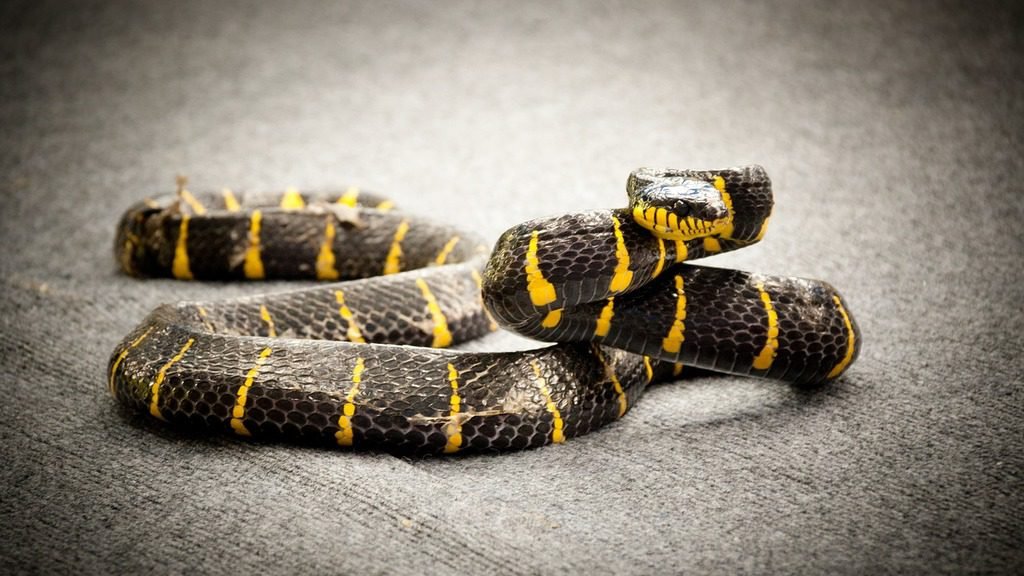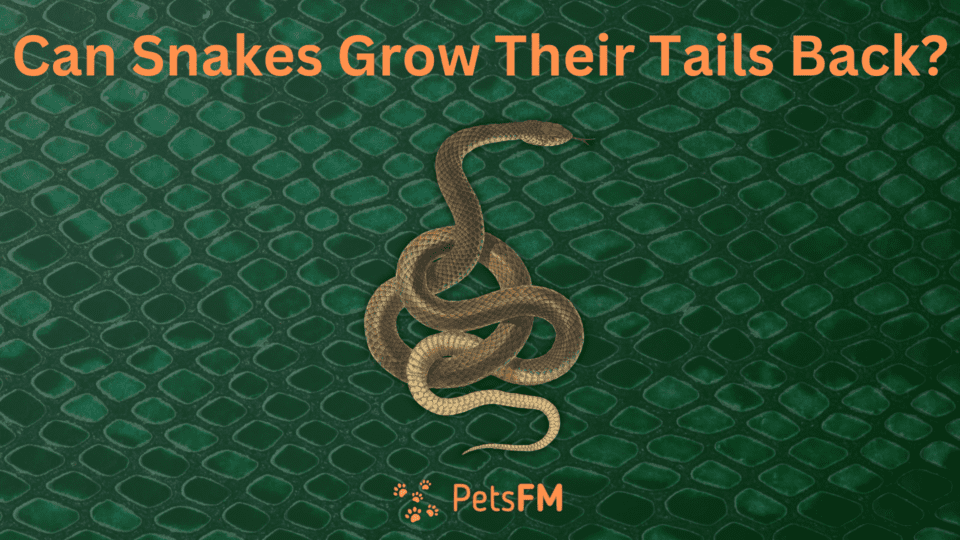


Learn if snakes can eat themselves to death [Answered]
February 27, 2024


Can Snakes Sense Pregnancy? (Myth Debunked)
February 28, 2024Snakes are fascinating creatures known for their slithering movements and unique survival skills. Many people wonder about their healing powers, especially when losing and possibly regrowing their tails. There are lots of stories and myths about what snakes can do. But what’s true?
Can these reptiles get their tails back after an injury, or is that just a tall tale? Let’s explore the world of snakes and uncover the facts behind their regenerative abilities.
However, here’s a quick answer: Snakes cannot regrow their tails like some reptiles can. While certain species can heal from minor injuries and regrow small portions of their tail tips, the regeneration is incomplete. Unlike lizards, which can regrow their tails fully, snakes can only heal the wound site, often resulting in scar tissue, without restoring the original structure and function of the lost tail segment.
Can snakes regrow their tails? Understanding the snake’s tail anatomy
A snake’s tail begins where its ribcage ends, marked by the cloaca, the opening for waste and reproductive functions. Unlike the rest of the body, the tail has no ribs, making it flexible. Inside, the tail comprises vertebrae (small backbone pieces) connected by muscles and tendons, allowing movement.
The tail’s length and shape vary among snake species and are used for tasks like gripping during climbing, swimming, or as a decoy to escape predators. The skin, covered in scales, protects the tail and helps in movement across various surfaces.
Snakes possess a limited ability to regenerate lost tail segments, a capability that significantly differs from the regenerative abilities observed in some other reptiles, such as certain lizards. The distinction between complete regeneration and partial healing or scar formation is crucial in understanding how snakes recover from tail injuries.
When a snake loses part of its tail, the wound site undergoes a healing process that involves the closure of the wound and the formation of scar tissue. This process does not recreate the original structure or functionality of the lost tail segment.
The new tissue may lack the complex muscular and skeletal structures present in the original tail, leading to reduced mobility and, in some cases, affecting the snake’s ability to catch prey or escape predators.


Black Mamba Snake
How do snakes respond to tail loss?
Snakes adapt biologically and behaviorally to cope with the change when they lose part of their tail. These adaptations help them survive despite their injuries.
1: Changes in mobility
After losing part of their tail, snakes experience changes in their movement. The tail plays a crucial role in balance and propulsion, so its loss can reduce a snake’s speed and agility.
This makes navigating their environment more challenging, especially when climbing or escaping predators. Snakes may have to adjust their slithering patterns to compensate for the reduced balance and control.
2: Hunting strategies
A snake’s hunting method may shift significantly following tail loss. Since the tail can be instrumental in luring and capturing prey, its absence might lead them to adopt more passive hunting techniques.
Snakes could become more dependent on ambush strategies, waiting for prey to approach closely enough for a strike. This change can affect the types of prey they can successfully capture and consume.
3: Overall health
The impact of tail loss on a snake’s health can be considerable. The open wound is susceptible to infections, compromising the snake’s condition. Additionally, the tail serves as a reserve for fat storage, which is crucial for periods of fasting or hibernation.
Without this resource, snakes may struggle with energy management, affecting their growth, reproduction, and survival chances in the wild.


Venomous Snake
What factors affect a snake’s ability to regrow its tail?
Many factors limit a snake’s ability to regrow its tail, making its regenerative capabilities much less pronounced than in other animals.
Understanding these factors provides insight into snakes’ biological constraints during recovery from tail loss.
1: The extent of the injury
The severity and location of the tail injury significantly affect the snake’s healing process. Minor injuries might heal with scar tissue, with minimal impact on the snake’s health.
However, more severe injuries can lead to significant tissue damage, making any meaningful regeneration impossible. The closer the injury is to the body, the more critical the impact.
2: Age of the snake
Younger snakes tend to have a slightly better healing capacity than older ones. This is because younger individuals generally have more robust growth rates and cellular activity, aiding in faster wound closure.
However, even in young snakes, the regeneration does not fully restore the lost tail’s structure or function.
3: Overall health and nutrition
A snake’s overall health and nutritional status play crucial roles in its ability to heal from injuries. Snakes in good health with access to adequate nutrition have better immune responses and can allocate more resources to healing.
Conversely, malnourished or sickly snakes may struggle with wound healing and are more susceptible to infections, further complicating recovery.
4: Genetic makeup
Genetic factors also influence a snake’s regenerative abilities. There is considerable variation within the animal kingdom regarding regeneration, and snakes, by their genetic makeup, are not predisposed to extensive regenerative capabilities like some lizards and amphibians.
The genetic programming of snakes emphasizes wound healing and scar formation over the regeneration of lost tissues.


Eastern Milksnake
How does tail loss affect a snake’s survival?
Tail loss in snakes can significantly affect their survival, affecting various aspects of their life, from mobility to reproduction.
Here’s how such an injury impacts their chances in the wild:
- Mobility and Balance: The tail helps with balance and agility. Losing it can impair a snake’s ability to move swiftly, affecting its ability to escape predators and catch prey effectively.
- Predator Evasion: A snake’s tail is sometimes used as a decoy to distract predators, allowing the snake to escape. Without it, a snake might be more vulnerable to attacks.
- Prey Capture: Some snakes use their tails to assist in capturing prey, either by constricting or as a lure. Tail loss can hinder these hunting strategies, making feeding more challenging.
- Reproduction: For certain species, the tail plays a role in courtship rituals and mating stability. Tail loss can, therefore, affect a snake’s ability to find and secure a mate, potentially impacting reproduction rates.
- Energy Reserves: Snakes store fat in their tails, which can be crucial for survival during periods of scarcity. Losing the tail means losing these reserves, which could be detrimental during hibernation or fasting.
Are there any medical interventions to help snakes with tail loss?
Veterinary care plays a crucial role in helping snakes recover from tail loss, offering various interventions to promote healing and prevent complications.
Here’s how professionals can assist in these situations:
- Wound Management: Immediate care involves wound cleaning to prevent infection, followed by appropriate dressing or suturing. This initial step is crucial for promoting healthy healing.
- Antibiotics and Pain Management: Vets may prescribe antibiotics to prevent or treat infections at the wound site. Pain relief medications can also help the snake cope with discomfort during healing.
- Surgical Interventions: In some cases, surgical intervention may be necessary to remove damaged tissue or to close large wounds. Such procedures help minimize complications and promote better outcomes.
- Rehabilitation Practices: Rehabilitation might include tailored environments that reduce stress on the snake and promote healing. Controlled temperature and humidity, for example, can aid in recovery.
- Nutritional Support: Proper nutrition is vital for healing. Vets might recommend dietary adjustments to ensure the snake has the nutrients to support tissue repair and overall health.
FAQs
Can a snake die from losing its tail?
While losing a tail is not immediately fatal for a snake, the aftermath can pose significant health risks. Infections at the wound site and the inability to effectively hunt or evade predators can lead to weakened conditions or death if not properly addressed through veterinary care and a safe environment.
Do snakes feel pain when they lose their tail?
Snakes do experience pain, including when they lose part of their tail. Their nervous system can sense injury, triggering pain responses. Handlers need to provide gentle care and seek veterinary assistance to manage pain and promote healing in such situations.
How long does it take for a snake to heal from tail loss?
The healing time can vary depending on the snake’s health, the extent of the injury, and the care provided. Generally, initial wound healing can occur within a few weeks, but complete recovery, including scar tissue formation and adjustment to the loss, may take several months.
Can anything be done to prevent tail loss in snakes?
Preventing tail loss involves ensuring a safe habitat free of sharp edges or tight spaces where tails can get caught. Handling snakes gently and avoiding stressful situations that might lead them to attempt escape can also reduce the risk of injuries leading to tail loss.
Conclusion
The myth suggests snakes can fully regrow their tails, but they can only heal with scar tissue, not restore the tail’s original form. Understanding this limitation highlights the need for conservation and careful handling to protect snakes from harm.
Responsible pet ownership and habitat preservation are vital in preventing tail loss and ensuring the well-being of these remarkable reptiles in both the wild and captivity.



